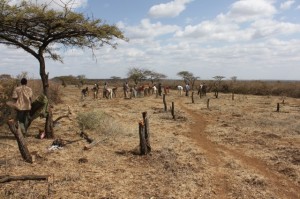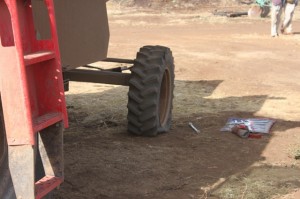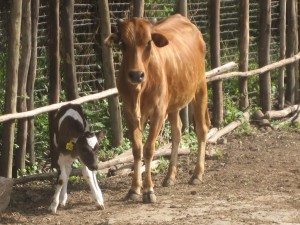Marty Petersen
Marty Petersen is the Chief Financial Officer for the operations of Morrell Agro Industries in Ethiopia. It falls under his primary responsibility to manage financing, accounting, and procurement, as well as the purchasing of any supplies or equipment needed to successfully run projects in the country. He also works with any legal issues that arise. Marty has worked for MAI since January of 2010 and he travels to Ethiopia to fulfill some of his responsibilities. He has previously worked for Paul Morrell, as the CFO of the projects in Iraq.
As for the projects ongoing in Ethiopia, Marty said, “Overall, we are trying to do things that will help the Ethiopian people.”
Alyssa Farm
The Alyssa farm is by far the largest project that Morrell Agro Industries has undertaken in Ethiopia. MAI leased from the government 10,000 hectares, or 25,000 acres, of land in Beltu to establish this farm. It is intended to be a farm that grows seed to sell to Ethiopian farmers to plant.
MAI has brought in dry season farming strains from the United States to plant at the Alyssa Farm. This is something that is new to Ethiopia. These US varieties of seed send their roots down deep into the soil where moisture can be found. The typical Ethiopian seed only sends roots out near the surface. In the dry season of Ethiopia, there is no moisture near the surface and the crops don’t survive. The new US seeds will survive in this type of environment, and these seeds will allow the people of Ethiopia to have a second growing season each year.
Employees of MAI began clearing the Beltu land at the Alyssa farm early in 2010. Beltu is a predominately flat area, dry and brown in every season but the wet season. There is brush and small trees scattered all over the land, many of them thorny. All of this has to be cleared before a section of land can be planted.
When asked about Beltu, Marty Petersen said, “We’re in the rainy season now, so the area is fairly green. But, for the rest of the year, it’s very brown and dry. The plants look pretty
dry, and in some cases dead, but they’re not. It’s just how they survive. It’s warm. It’s on the equator. It’s about 5,000 feet above sea level, so it gets pretty hot down there… Addis is located only a little below 8,000 feet above sea level, so it remains a little cooler in Addis year-round.”
In order to clear the land for the establishment of the Alyssa farm, MAI employed 2,750 people for little over a month. Most of these laborers are local Ethiopian people, while some people were brought in to the farm from larger distances to fill skilled positions. They cleared the land using largely hand labor, although some of the land was also cleared using front-end loaders to pull out tree stumps and other obstructions.
They have currently cleared close to 2,000 hectares, or 5,000 acres. The land clearing on the Alyssa farm is taking longer than first expected. One reason for the slow progress was the way that laborers on the farm were paid to manually clear the land when the project initially began. They were first being paid on an hourly basis, which didn’t give them an incentive to work very hard. When the compensation method was changed to a per hectare cleared basis, progress on the farm speeded up quickly.
The second reason that the land clearing is taking so long is that the tree stumps on the land are harder to deal with than anticipated. Typically stumps are burned, but they don’t burn very well when they are green. So, the stumps on the farm had to be dug out using front end loaders. It was more cumbersome and difficult than expected. The stumps also cause many flat tires on the tractors and loaders on the farm, so it takes time to fix all of them.
A little less than 2,000 hectares was planted in the March/April planting season.
Planting on the farm was done using traditional Ethiopian methods, although it was mechanized. The seed was not thrown out on the ground by hand; instead it was sown by a tractor using the broadcast method of planting. Seeds and fertilizer are spun out behind a tractor, in no specific pattern.
The plan going forward on the farm is to use air drills. This John Deer equipment places the seed in furrows, along with fertilizer, so much less seed is used in the process. Seeds also get placed exactly where they are needed. This method of planting could not be used for the March/April planting season, as the equipment had not arrived, yet.
The seed planted this season is growing as expected, and the wheat crop on the farm is currently about two feet tall. The first crop from the Alyssa farm is expected to be harvested in July and August. A second crop will be planted in September. It is the intention to plant this second season using seed harvested from the first season crop. Since all of the seeds will not be needed for planting, any additional seed will be sold, although they may time the sell to coincide with better pricing in the market.
Beltu is located about 225 kilometers from the capital city of Addis Ababa. By car, the drive from Addis to Beltu can take one and a half to two days. Part of the reason for the lengthy travel time is that the roads are very rough and basically in the middle of nowhere. In the rainy season, the roads are even more difficult to navigate. If it’s rained, trucks cannot get through the river that the road crosses.
Marty said, “It’s very difficult and challenging road to traverse to get goods to the farm. Logistically, it’s a big challenge.” Since Addis is where most of MAI’s supplies come from, it is part of the MAI project to build and improve the road infrastructure so that travel time is reduced.
There is also construction occurring on the Alyssa farm to make the property easier to manage and work. They are currently building housing for MAI staff and dorms for the other workers. They will also be building warehouses, mechanic shops, and a seed cleaning facility, as well as anything else that is required to operate a farm of that size. A landing strip has also been built on the property so that small planes can land there when needed.
It is currently expected that the entire 10,000 hectares under lease will be cleared and planted by the middle of 2012.
Marty Petersen believes that the Alyssa farm project will be beneficial for Ethiopia. He said, “We are propagating seed that can help them produce grain in the dry season, giving them basically a second season to plant. That is going well. We’ve had a lot of hiccups. Some of which have come because the government hasn’t done what they were expected to do in the timeframe that we needed them to do it. Some are just our own hiccups, because we’re learning what’s required there. We didn’t really know exactly what we would encounter, and we’re having to adjust. But, I think overall it is going well.”
Kokosa – Diary
Kokosa, Ethiopia is located about 225 kilometers from the capital city of Addis Ababa. By car, the drive from Addis to Kokosa takes about seven and a half hours. When asked about Kokosa, Marty Petersen said, “It’s up in higher elevations, absolutely gorgeous country, very green and lush, and just beautiful country.”
MAI has leased, from the government, 350 hectares of land in the Kokosa area. The land has been leased from the Ethiopian government for thirty years, on the condition that MAI build a working dairy on the property.
The typical cow in Ethiopia produces significantly less milk each day than cows in the United States, so, as part of the MAI program in Ethiopia, staff will be working to improve the milk production of cattle in the country. This will be achieved by a number of means. Cows will be given feed supplements that will help them stay healthy, and the farm property will be managed so that it does not become overgrazed. Lonny Ward, the employee of MAI who heads the Kokosa project, will also utilize the methods of embryo transplant and artificial insemination to build a herd on the property.
Just a few weeks ago, six pregnancies resulted in the birth of Holstein cows in Ethiopia, after transferred embryos were a success. The goal is to build a herd that can produce more milk than typical Ethiopia cattle so that a productive and profitable dairy can be built in the area.
Abera Chala is the Ethiopian man who manages the property in Kokosa, while he reports to Lonny Ward. He previously worked for MAI doing work in Kersa Illala.
MAI’s goal for the Kokosa property is to build a productive dairy, which will sell milk, and possibly cheese, to the Ethiopian markets. Marty Petersen added that the Kokosa dairy will be located in a remote place in Ethiopia, and while milk is common in the local markets, and regularly consumed by the Ethiopian people, cheese is not typically eaten. Marty said, “We’re producing something that is not a staple in their diet. It may or may not work. If they start consuming it, it should be good.”
A slaughterhouse will also be built on the farm. It is possible that alfalfa will be planted, as well, which can then be used for hay. There is good feed on the ground, but it could be improved with the addition of alfalfa.
Fruit Tree Initiative
Lloyd Ward is the employee of MAI who is primarily responsible for the fruit tree project in Ethiopia. There has not currently been much activity in the project. The goal of this project is to help the Ethiopian people by introducing fruits that grow well in the country’s environment, which is also good fruit for them to eat.
The objective of this project was to send fruit trees from the United States to Ethiopia. Tree and fruit species were selected based on what could potentially do well in the country, varieties that local people would like, and what was nutritious.
These imported seedlings were to be planted on a property allocated to MAI by the Seventh Day Adventist School. They would be planted for research purposes and then watched and cared for properly, to see how the fruit performs in Ethiopia.
But, when the trees got to Ethiopia, they had to be cleared through customs. The Ethiopian government decided that they wanted to be the ones to manage the trees, and they took ownership of them. MAI will still have access to the trees to study them when needed, although they will have to assume that they are planted and cared for properly.
According to Marty Petersen, the MAI fruit tree project, “In the extent that we discover types of fruit that work well and are liked by the Ethiopian people, that will help them.”
Sisal Initiative
A new project in the works for MAI in Ethiopia is the sisal initiative. Mike Rhodes heads the work in this project. Sisal is a plant in the same order as aloe vera. It produces a stiff fiber that is used to make bags, rope, twine, and other products. There is a need for these products in Ethiopia, so the project is being explored. At the current time, it has not been determined that the project will be cost effective.
When asked about the sisal project, Marty Petersen said, “If that works, that would help the Ethiopian people. Because the format is to basically help lots of individual farmers grow this. And, then we would provide them with not just seeds, but also expertise and know-how on producing it, and basically help them become more self-sufficient, each of the farmers. I think that there’s a lot of benefit that can come from that.”
Arsi Negele Research Center
Arsi Negele is located in the Oromia region of Ethiopia, close to Shashamene. The MAI offices in the Kersa Illala area are sited there at the Arsi Negele Research Center. There MAI has control of different plots of land under lease, either directly from the government or subleased from others with leases from the government. The research center provides a place to plant different grains, legumes, or fruits and test their growth in an Ethiopian environment. It provides support to other future operations of MAI in the country.
Marty Petersen said, in regards to the research center, “That’s just in support of our other operations that really are geared toward helping the Ethiopian people in some way.”
Village of Hope
The Village of Hope orphanage and charity in Kersa Illala is being restructured. It will have a new name. Wally Odd, an employee of MAI, is helping to further the work on this project.



